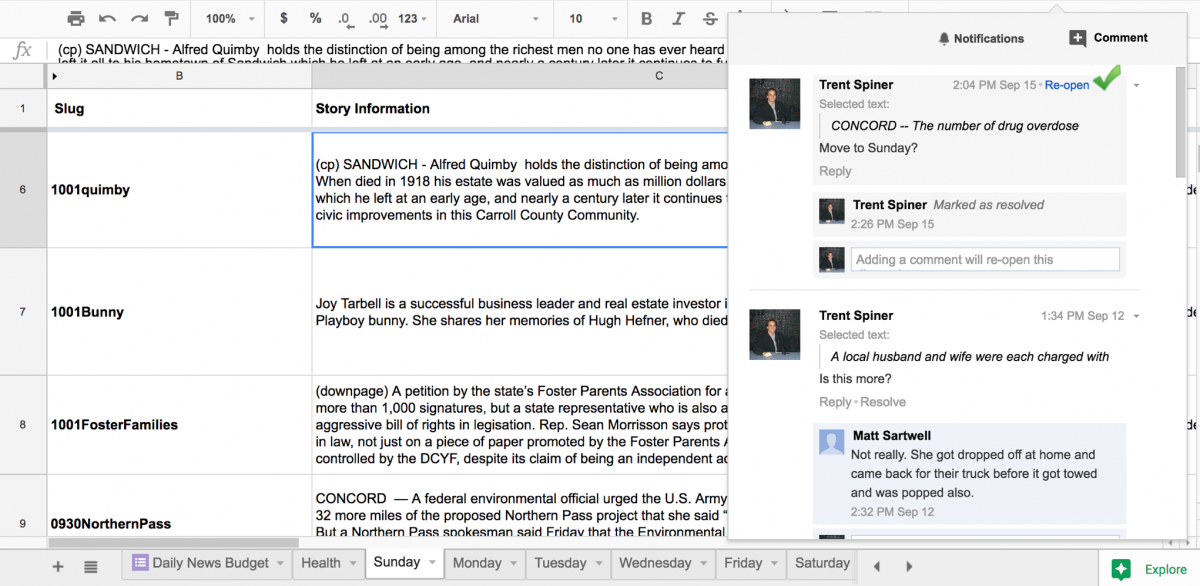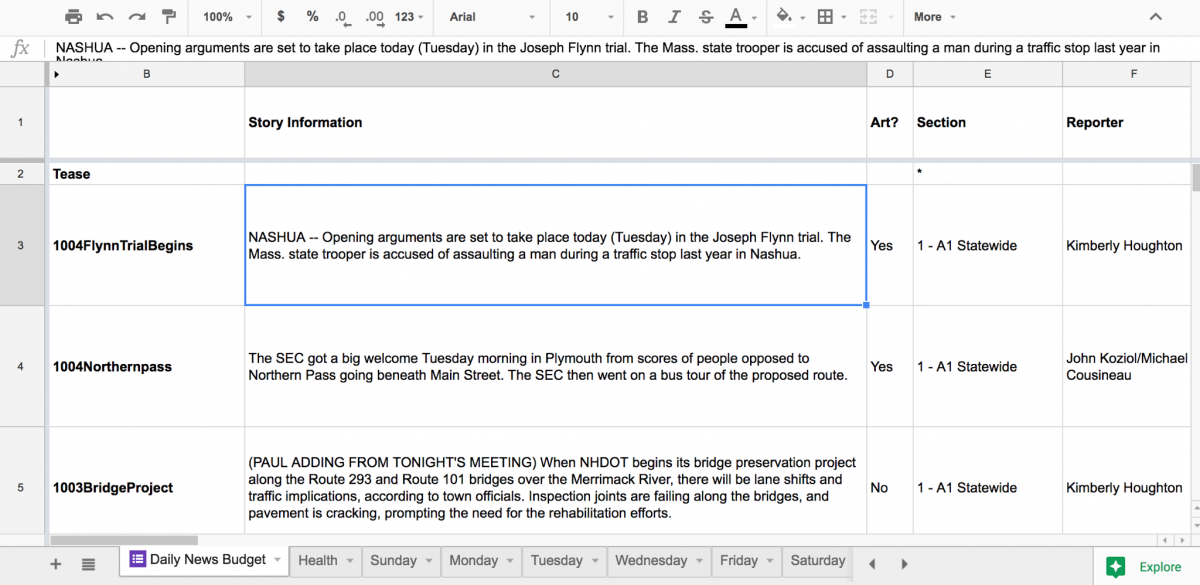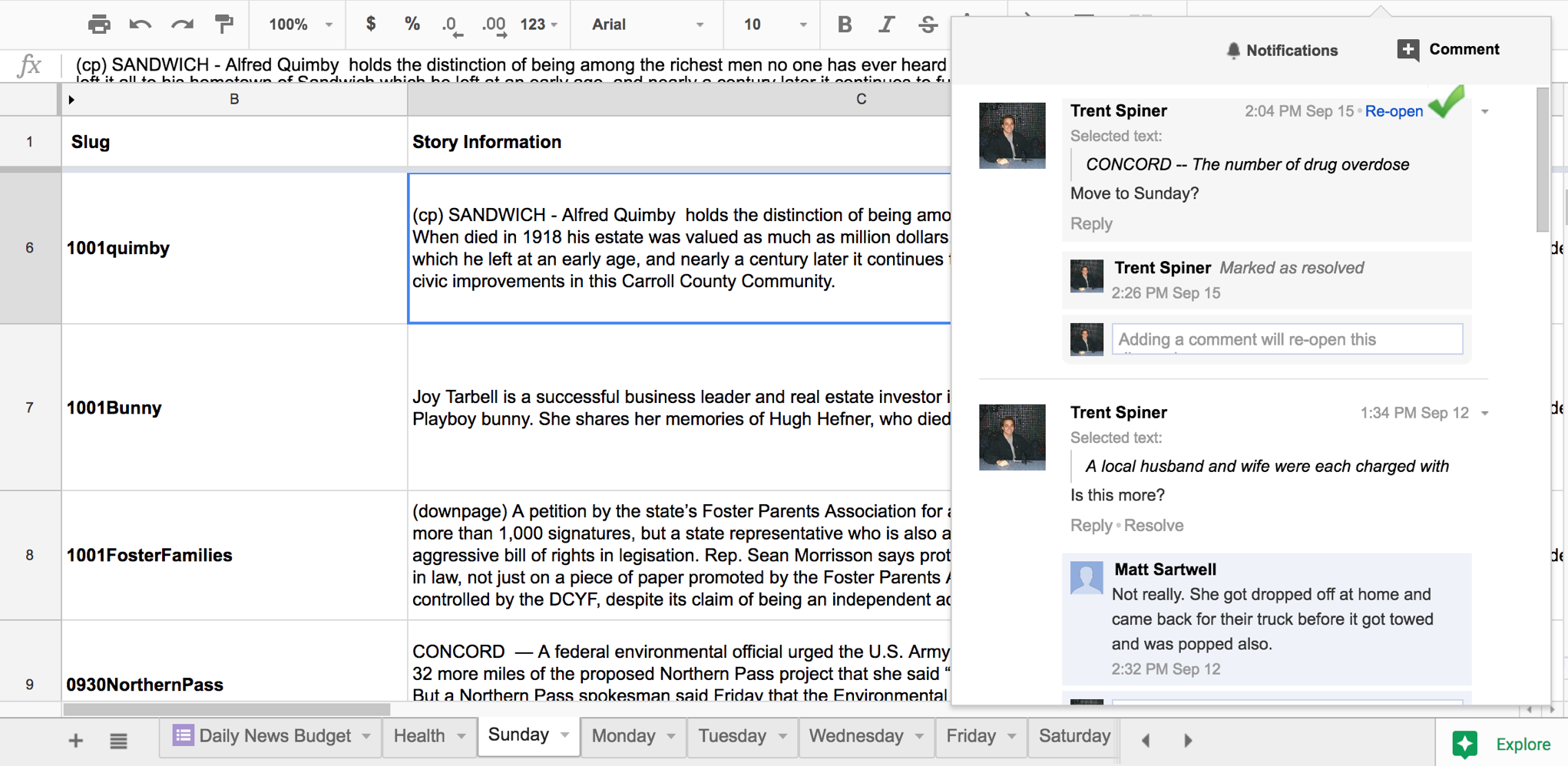A time-saving story assignment tool gives New Hampshire newspaper an edge
When Trent Spiner became executive editor of the The Union Leader in 2014, he wanted to modernize the thought process of New Hampshire’s only statewide daily paper. Spiner had spent time as an independent correspondent for the paper and knew his way around the newsroom. But as executive editor, he sensed that the newsroom’s efficiency wasn’t what it could be.
“I saw that there was essentially an editor here who spent his entire day just working on figuring out what everyone else was working on,” Spiner says. “And I said to myself, ‘there’s got to be an easier way.’”
Spiner set about creating News Budget, a real-time spreadsheet that allows Union Leader editors and reporters to track which stories need to be covered, which stories are under construction and which stories are ready to be disseminated to readers. The tool is still just called News Budget, Spiner admits. The team hasn’t yet found a sleek, sexy name for their time-saving gizmo.
“We’re open to suggestions,” Spiner says with a laugh. Storybench sat down with Spiner to figure out how News Budget is helping a traditional newspaper work smarter in the 21st century.

What is the News Budget tool and how is it useful?
It’s a tool that we’re using here that allows you to track every single story that we’re working on in real time. If you think of the old days, you had an editor who would kind of walk around the newsroom and say, “what are you working on today?” and then there would be a conversation about it. Now, what we’re able to do is do that with everyone in the newsroom, at the same time, live.
We also have a whole slew of correspondents and freelancers who are spread out across the state. They’re also inputting into this system. So, at one click of a button, we can see what everyone’s working on today, for the Sunday paper, for our special sections. It eliminates a massive amount of time that used we used to spend on figuring out “what’s going on today?”
How does it work?
The whole thing lives on Google in Google’s cloud. It’s essentially a Google survey form that feeds into a larger Google Sheet. If you have a basic understanding of how that works, it’s not a terribly complicated thing to do. You can also use the Google Chat feature. If there’s breaking news and we’re dealing with a correspondent in the field, and I’m in a meeting and the managing editor’s in the newsroom, we can all chat live about what’s going on. You can access it from a desktop, a laptop or a smartphone.
“Any newsroom can do this.”
Any newsroom can do this. This is not an expensive task. I think we always hear from people that they can’t afford it. I think that newsrooms can’t afford not to have a budgeting tool that is this usable.
What was the initial goal in creating News Budget?
Our big goal at The Union Leader is to be publishing online, constantly throughout the day. I can sort the sheet by reporter, by section, by time of the day. As stories are coming in, I’m able to plan to have them posted, and I can think about what I can start teasing on social media.
I wanted to develop a program that I can click one button on my phone and see what everyone is working on. I have a reporter who covers all the way up to the border of Canada where there’s very little cell service. How can he make sure that he can communicate with us? There’s really nothing out there like it, so I, along with my editors, decided to build it myself.
It also helps for planning our Sunday paper, and making sure we have evergreen content ready to go on slow news days. Many newspapers don’t have a good bunch of evergreens ready to go. This tool lets you see how many evergreens you have. Rather than coming into an editor’s office and debating whether or not this should be held, reporters can now pitch evergreens right on the evergreen budget.
In a lot of newspapers our size, a lot of editors are walking around the newsroom on Thursday or Friday saying, “Hey, can you get me something for Sunday?” Now everyone in the room can click on Sunday and see how many stories we have throughout the week.
Can you think of any specific times where having the News Budget tool would have really came in handy?
Funny enough, it happened on my first day as editor in 2014. There was a burglary at a house. Somebody had heard it over the police scanner – and sometimes over the scanner you can’t hear very well – so the house number came over as someone that was running for governor. That’s a big story; this is a possible burglary at a candidate for governor’s house. The editor heard this and sent the tip to a few people; one was our correspondent for the area, one was our crime reporter back in Manchester, one was an editor that handled state news.
A couple hours later I got a call from the police chief of that town, who I’d known for many years. He told me five different people from The Union Leader called about this story. That’s kind of a waste of time. Now, rather than those five different people wasting half an hour of their day trying to make the same calls that someone else already made, they can see that the story’s on the budget already and go from there.

How important is the News Budget for The Union Leader, a paper that operates across the entire state?
It’s hugely important. We’re the only statewide newspaper in New Hampshire and we have a good number of reporters and editors who are working every day. You have to take every opportunity you have to kind of streamline your workflow so that you don’t have two people working on one story or so that you don’t have an editor spending time trying to figure out if something has been assigned. Every single time you can save five minutes there, 15 minutes there of reporting time or editing time, that’s time that gets invested back in the product that makes the final product better.
You also introduced Parse.ly, a live time digital engagement analytics tool, to The Union Leader. How has that helped improve the newsroom?
Parse.ly is a program where you can see how many people are reading your stories, what stories they’re reading, how long they’re reading the stories, where they’re going and where they’re coming from. It’s a digital tracking tool that’s incredibly powerful.
A lot of traditional newspaper outlets have not done a good job of understanding who their audience is – and not only who their audience is, but all the different segments within their audience. What I wanted to be able to do was show not only the editors, but also reporters here, what types of stories draw in what types of audiences to help them become more effective.
Every morning they’re trying to figure out “What am I going to work on today?” Now they at least have some idea of what people are talking about and what people are thinking about that they didn’t have before.
- A time-saving story assignment tool gives New Hampshire newspaper an edge - October 11, 2017





